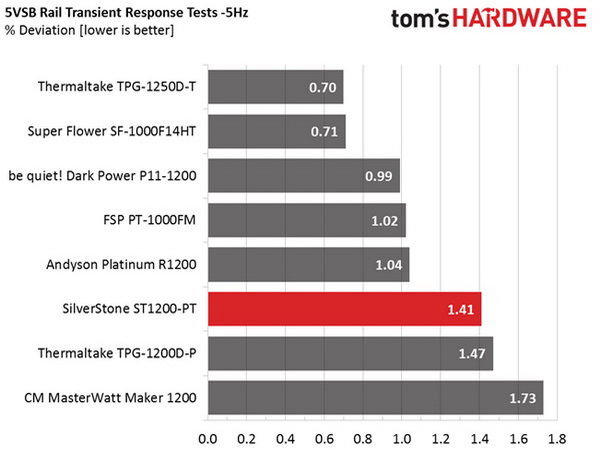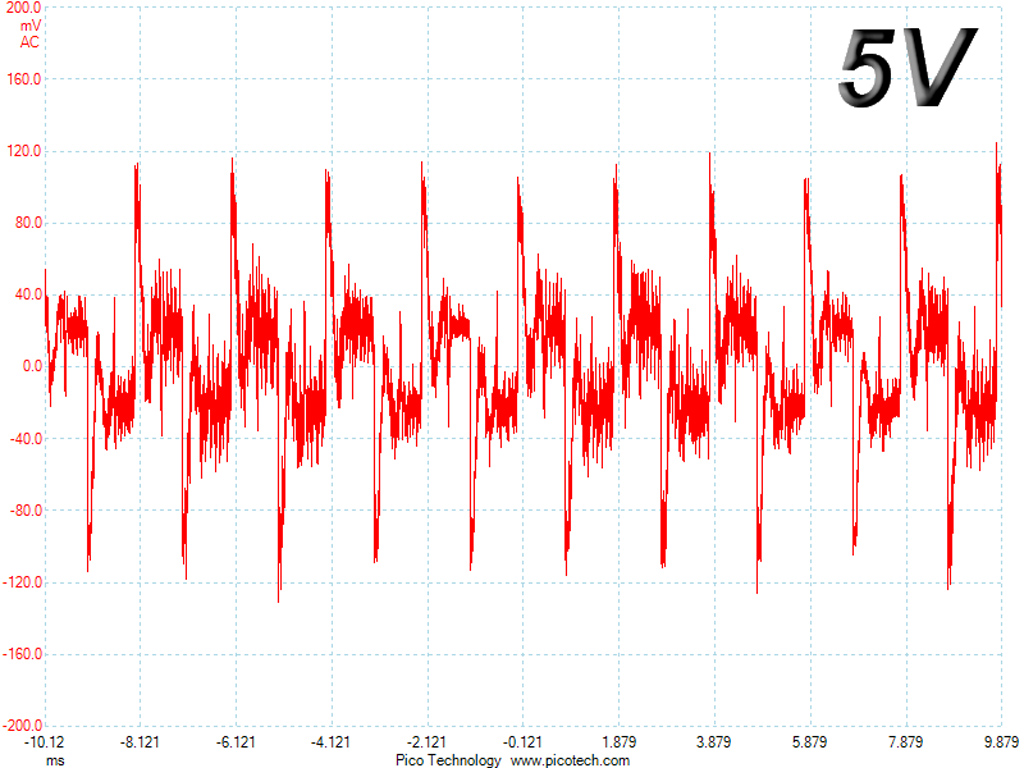SilverStone Strider Platinum ST1200-PT PSU Review
The highest-end member of SilverStone's Strider Platinum line is the ST1200-PT, and we're ready to give it an exhaustive evaluation. It achieves a high power density score thanks to compact dimensions, and there's that 1200W capacity. But is this enough?
Why you can trust Tom's Hardware
Transient Response Tests
Advanced Transient Response Tests
For details on our transient response testing, please click here.
Ιn these tests, we monitor the ST1200-PT's response in several scenarios. First, a transient load (10A at +12V, 5A at 5V, 5A at 3.3V, and 0.5A at 5VSB) is applied for 200ms as the PSU works at 20 percent load. In the second scenario, it's hit by the same transient load while operating at 50 percent load.
In the next sets of tests, we increase the transient load on the major rails with a new configuration: 15A at +12V, 6A at 5V, 6A at 3.3V, and 0.5A at 5VSB. We also increase the load-changing repetition rate from 5 Hz (200ms) to 50 Hz (20ms). Again, this runs with the PSU operating at 20 and 50 percent load.
The last tests are even tougher. Although we keep the same loads, the load-changing repetition rate rises to 1 KHz (1ms).
In all of the tests, we use an oscilloscope to measure the voltage drops caused by the transient load. The voltages should remain within the ATX specification's regulation limits.
These tests are crucial because they simulate the transient loads a PSU is likely to handle (such as booting a RAID array or an instant 100 percent load of CPU/GPUs). We call these "Advanced Transient Response Tests," and they are designed to be very tough to master, especially for a PSU with a capacity of less than 500W.
Advanced Transient Response at 20 Percent – 200ms
| Voltage | Before | After | Change | Pass/Fail |
|---|---|---|---|---|
| 12V | 12.131V | 12.044V | 0.72% | Pass |
| 5V | 4.989V | 4.881V | 2.16% | Pass |
| 3.3V | 3.322V | 3.199V | 3.70% | Pass |
| 5VSB | 4.974V | 4.902V | 1.45% | Pass |
Advanced Transient Response at 20 Percent – 20ms
| Voltage | Before | After | Change | Pass/Fail |
|---|---|---|---|---|
| 12V | 12.131V | 11.968V | 1.34% | Pass |
| 5V | 4.991V | 4.879V | 2.24% | Pass |
| 3.3V | 3.324V | 3.161V | 4.90% | Pass |
| 5VSB | 4.977V | 4.887V | 1.81% | Pass |
Advanced Transient Response at 20 Percent – 1ms
| Voltage | Before | After | Change | Pass/Fail |
|---|---|---|---|---|
| 12V | 12.130V | 11.981V | 1.23% | Pass |
| 5V | 4.990V | 4.875V | 2.30% | Pass |
| 3.3V | 3.324V | 3.111V | 6.41% | Fail |
| 5VSB | 4.976V | 4.882V | 1.89% | Pass |
Advanced Transient Response at 50 Percent – 200ms
| Voltage | Before | After | Change | Pass/Fail |
|---|---|---|---|---|
| 12V | 12.076V | 11.991V | 0.70% | Pass |
| 5V | 4.955V | 4.854V | 2.04% | Pass |
| 3.3V | 3.299V | 3.169V | 3.94% | Pass |
| 5VSB | 4.937V | 4.869V | 1.38% | Pass |
Advanced Transient Response at 50 Percent – 20ms
| Voltage | Before | After | Change | Pass/Fail |
|---|---|---|---|---|
| 12V | 12.076V | 11.952V | 1.03% | Pass |
| 5V | 4.956V | 4.849V | 2.16% | Pass |
| 3.3V | 3.299V | 3.121V | 5.40% | Fail |
| 5VSB | 4.938V | 4.876V | 1.26% | Pass |
Advanced Transient Response at 50 Percent – 1ms
| Voltage | Before | After | Change | Pass/Fail |
|---|---|---|---|---|
| 12V | 12.076V | 11.949V | 1.05% | Pass |
| 5V | 4.955V | 4.826V | 2.60% | Pass |
| 3.3V | 3.299V | 3.088V | 6.40% | Fail |
| 5VSB | 4.937V | 4.854V | 1.68% | Pass |





Using a 5 Hz load-changing repetition rate, the 3.3V rail starts to show a weakness, which is verified with faster load-changing rates. The other rails perform well enough, although we would like to see even lower deviations on the +12V rail given this PSU's high capacity.
Get Tom's Hardware's best news and in-depth reviews, straight to your inbox.
Here are the oscilloscope screenshots we took during Advanced Transient Response Testing:
Transient Response At 20 Percent Load – 200ms




Transient Response At 20 Percent Load – 20ms




Transient Response At 20 Percent Load – 1ms




Transient Response At 50 Percent Load – 200ms




Transient Response At 50 Percent Load – 20ms




Transient Response At 50 Percent Load – 1ms




Turn-On Transient Tests
In the next set of tests, we measured the PSU's response in simpler transient load scenarios—during its power-on phase.
For the first measurement, we turned off the ST1200-PT, dialed in the maximum current its 5VSB rail could output, and switched the PSU back on. In the second test, we dialed the maximum load the +12V rail could handle and started the 1200W supply while it was in standby mode. In the last test, while the PSU was completely switched off, we dialed the maximum load the +12V rail could handle before switching it back on from the loader and restoring power. The ATX specification states that recorded spikes on all rails should not exceed 10 percent of their nominal values (+10 percent for 12V is 13.2V, and 5.5V for 5V).



We observe very good performance in these tests, since all slopes ramp up smoothly with only a small voltage overshoot.
Current page: Transient Response Tests
Prev Page Cross-Load Tests And Infrared Images Next Page Ripple Measurements
Aris Mpitziopoulos is a contributing editor at Tom's Hardware, covering PSUs.
-
powernod Wow!! Extremely impressed with Aris's more thorough "Advanced Transient Tests" !!Reply
Great to see a reviewer who never stops evolving his work!!
Amazing work Aris !!! -
Metteec Nice review, Aris. $233 is a lot to spend on a PSU. You can get a Corsair HX1200i for $210 after mail in rebate, which is a well-regarded PSU with a 7-year warranty.Reply -
jeffunit "...and as you can see, the glossy silver surface makes taking pictures difficult."Reply
It sure does, because the pictures have the exterior looking like matte black.